The curious hidden exit of West Finchley station opens onto the long suburban wind of Nether Street. By the 14th century this route, sometimes known as Lower Street, was already regarded as an ancient way. Now it trickled with Saturday morning traffic and occasional joggers, a string of quiet local stores leading away from the station. A quick survey of my surroundings indicated the distinct declivity to the west of the road, and a short trek between ranks of pleasant homes led me towards the bottom of the valley. From the top of Fursby Avenue a pair of glowering youths, hooded and hands wedged into pockets watched me from a bench, occasionally spitting on the ground. I felt their frustration - it must be hard to rebel in Finchley, where there's almost no-one around to pass judgement. I glanced back, hoping that they'd recognise my effort, before I plunged into the trees and began my walk along the Dollis Brook. I could have struck out further north, given how eminently walkable this tiny but proud waterway is - but in truth even coming this far had been a last minute decision. This walk had a difficult genesis - one option among three, in a month where I knew I'd be in London more than once. I'd originally intended to disembark further south to pick up the River Brent at Hendon, or the Dollis Brook at Finchley Central - but here I was just close enough to the edge of things to feel like I was walking into London. If the fairly exclusive golf course would permit it and I could strike out directly north west, I'd find myself crossing open countryside as far as the M25 at London Colney. These strange frontiers with their unsettling sense of being the last-street in London exist all around the perimeter, but perhaps feel strangest here on the northern flank of the city. Whatever the circumstance which got me here, it felt good to be walking beside water. Easing a sore left foot into action, I set off along the course of the brook which edged around allotments busy with gardeners hauling in their late crops.
Having tramped the edges of a good number of waterways in London, I'm used to being largely alone on these walks. The occasional cyclist or jogger sometimes appears, but largely the footpaths which flank streams and rivers seem to be off-limits on weekend mornings. The officially sanctioned activities take precedence: shopping, DIY and so on. The Dollis Brook however, appeared much beloved by the locals. My walk through the edges of Finchley was busy with dog walkers who shadowed me: when I paused to take a photograph they seemed to stop to watch their animal grubbing in the generous carpet of leaf-fall. When I set off again, I'd hear the panting and pattering behind me. It was clear that being out here without a lead dangling from my wrist marked me out as an odd-ball. The owner of a particularly nervous little terrier asked me urgently "Is your dog behind you?" presumably worried it would go for her trembling charge. When I replied that I didn't have a dog with me, her relief quickly turned to concern. If I wasn't walking a dog here, what on earth was I doing? The brook babbled pleasantly, but it seemed to be nothing more than a backdrop - for the young religious pamphleteer who was regretting starting a conversation about Jesus with a park drinker, or for the pair of designer-clad women trying to navigate their way through a conversation about a Muslim friend who wore a veil at a wedding with their liberal credentials intact. "Well of course if she chooses to...." "Yes, but I'm not sure if it's sexist, or racist. Y'know?" "Maybe it's a personal thing really. Not our business?" "No. We can't judge" "But she did look stunning!". Their dogs, ignored and bored by the chatter, plashed into the nearby brook.

The path crossed and recrossed the Brook to negotiate a minor tributary joining from the east at Lovers Walk, then skirted a pond almost entirely buried within the trees which lined the valley. Suddenly, I was deposited on Dollis Road - a furious B-road which lurched around a blind bend from Finchley to Mill Hill, traffic barely slowing for the curve. Forced to cross the road, I carefully waited time before heading under the slender legs of Dollis Brook Viaduct. This tall copper and honey-coloured brick structure carries the rather forlorn stub of the Northern Line over the Dollis Valley towards Mill Hill East station, providing the so-called Underground with its paradoxical highest point above sea level. The line which passed overhead had suffered a chequered history: opened in 1867, the Great Northern Railway's line to Edgware was reduced to a branch line as early as 1872 when the line from Finchley to High Barnet came into use. Transfer to London Transport in the 1930s offered a new lease of life to the line, and double-tracked and electrified it would form part of the ambitious Northern Heights plans, with a new link to Edgware and beyond to the speculative new horizons of Bushey Heath approved. The war intervened - but unlike many of the schemes slated for delivery, a little work was actually completed with a single track over the viaduct electrified and opened to Mill Hill East station in 1941. However, that is largely what has remained since, and now outside the peaks a shuttle train operates high above the valley, with the course of the railway beyond now largely developed but still discernable by the broad curving sweep of new-build homes on its tell-tale footprint. I lingered under the viaduct long enough for the shuttle to clatter overhead, road traffic drowning out the noise of the train. Rather like the Piccadilly Line's crossing in Arnos Park, the row of voids in the brickwork stretched ahead creating a strange optical illusion of infinite arches, and under the nearest arch the brook trickled, unheard and unremarked by the passing drivers.
Beyond the railway viaduct, the path beside the brook was hemmed into a narrow green tunnel between suburban streets, and again it was the preserve of dog walkers with their evident suspicion of those without canine accompaniment. At Windsor Open Space the path opened into a wider linear park, spreading to the east of the Dollis Brook. I had passed close by before and soon found familiar territory where the footpath sloped down into a narrow subway to pass under the A504. Soon afterwards a bridge carrying the arms of Middlesex lifted the traffic of the Great North Road over the valley towards its confluence with the North Circular. I made slow progress through these bottlenecks, pausing to let dogs pass by, with their panting owners trotting after them in pursuit. This area was familiar from walking around the North Circular, and I noted the pleasant little playpark where the Mutton Brook trickled in from the east, a family of children clambering over the equipment while a tired mother lay back in the surprisingly bright morning sun. Nearby the Dollis and Mutton Brooks finally met with their joined waters becoming the River Brent, which started its sluggish swing to the west by skirting Decoy Pond and forming the western extent of Brent Park. The North Circular was asserting its presence here, and I was reluctant to encounter it. I've no objection to the road - and even have something of an affection for its strange loop around the northern suburbs of London - but I felt like in some ways I was still processing the complete circle I'd recently completed. There was however, no escape from Brent Park without briefly joining the haze of dust and fumes, as I encountered the first of many surprising and frustrating diversions here with a footbridge and park exit onto Brent Street closed for repairs. I stepped reluctantly onto the pavement beside the six lanes of traffic, knowing that the twinge of protest I felt in my foot as I misplaced it on a flagstone was the price I'd pay for walking beside this road today. As soon as possible I retreated into Brent Street and took to the side streets of Shirehall Park. The rumble of the road was never far away as I ambled between decent villas and pleasant gardens tucked into a curious corner between the North Circular and the A41. A family wandered towards their car, either unconcerned or resigned to the road and its environs being a guilty, dark orange stain on the Mayor's recently released pollution map. I crossed briefly into the scrappy edge of Hendon Park to climb the footbridge over the Edgware branch of the Northern Line, soon finding myself beside the impassable shudder of the A41. To the south the road was soon entangled in the complex junction with the North Circular - I'd negotiated that before and I didn't have the energy or patience today. Instead I struck out north along the rather typical arterial route flanked by rows of fine houses which never expected to sit on such a major route. I soon found a grubby subway beneath the carriageways which delivered me to the road's western side immediately beside a pedestrian entrance to Brent Cross Shopping Centre. It wasn't what I'd planned, but it was time to brave a crossing of the retail jungle.
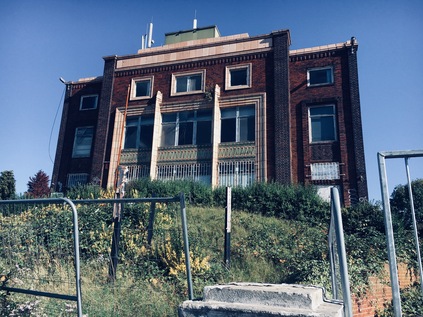
Getting into the Shopping Centre was the first challenge. The sloping footpath led me along the edge of an orbital route, peppered with roundabouts and zebra crossings which appeared to be entirely ignored by the drivers racing for parking spaces near to the doors. Once within the loop of access road the signs 'To The Shops' led me between two huge concrete car parks, towards the functional grey rear of the structure. The path divided and I could 'Use both doors for shops'. I muttered 'surely either?' to myself but realised that Brent Cross isn't interested in the individual shopper - it speaks to the collective mass. Some of them had already arrived. Less than an hour into the centre's day, there was a dedicated band of customers sluggishly navigating the complex, scoping out their next move. They moved slowly, filling the broad aisles and failing to acknowledge my sweaty bustling around. I wanted out of here as soon as possible - malls unsettle me. Never comfortable with large empty spaces, the weird light and muted echoes of sound disturb my balance and awareness just enough to make me queasily nervous. I shuffled behind the touring bands of shoppers to the toilets, then down into the lower levels to find a cold drink. I settled for a nearby WH Smith rather than detouring back towards other options. The crowds had grown steadily since I arrived, and they were even less inclined to give way than the cyclists and dog walkers on the river path. I struggled out through John Lewis into the car park, and didn't pause until I'd skirted the car park and found another footpath out of the site. I didn't particularly care if I looked suspicious on the plentiful forests of CCTV cameras now - it felt like an age since I'd felt the less-than-fresh air outside. I slowed my pace, walking gratefully along Brent Park Road, and considering my options. The river ran parallel to my route, but to take a closer walk along it would involve navigating the complexities of Staples Corner once again. While the return to the North Circular hadn't felt as jarring as I'd expected, thoughts of navigating the highwalks and crossings at that junction once again weren't edifying. Instead I passed under the concrete embankment carrying the nascent M1 and then negotiated a series of ever-lower bridges carrying slip roads and the tracks of the Midland Main Line. Finally I emerged on the A5 - following the straight track of Roman Watling Street. Crossing the tide of traffic divided by a high metal fence was impossible - instead I needed to walk north here, towards West Hendon and the start of a recent walk. The growing decay of the businesses along the main road was starkly contrasted with the tall, modern apartment blocks growing behind the Victorian terraces and tired 1980s car sales forecourts, offering views across the reservoir. The decorative frontage of Philex House was a welcome surprise, derelict but still remarkably detailed and impressive. The still extant electronics company had followed the pre-Olympic exodus of industry up the Lea Valley ending up in Bedfordshire, but its fine old headquarters still stood - for now at least. I finally crossed the street at the curiously named Cool Oak Lane - a brand new Range Rover occupying the central lane with his bumper distorted from a recent skirmish at the lights. He gestured angrily at his 'phone behind the toughened glass windscreen - a mute rage at the injustice of the A5. Meanwhile Cool Oak Lane was remarkably close to where I'd crossed the street previously, and I kicked myself for not having spotted this way to Brent Reservoir. The lane narrowed to a tiny bridge over the neck of the lake, cars signalled over in turn. I spotted a crossing button and pressed, claiming my own pedestrian-timed gap in the sequence. No time to snap a shot of the vast body of water stretching to the south west and shimmering with bird life. I had to reach the west bank before the tones ended.
The northern banks of Brent Reservoir felt pleasantly wild and unloved. The rough path littered with cracked horse chestnut shells and a growing mulch of fallen leaves, climbed to shadow the water but remained within the tangle of autumnal woodland. The footway wound around the lake, dipping inland to avoid denser clumps of trees, with occasional cleared areas leading towards the lake to allow access for fishing points or views across the silvery water. Waterfowl clucked and skittered from the undergrowth into the deep, cold water. Autumn had certainly come to Brent, and I sensed darker skies closing in after the sunny morning. I realised I could have scrubbed around to find an obscure path beside the river had I stuck to the south bank, but I'd have effectively been delivered to the same problem: Neasden. The widening fan of sidings around Neasden Depot present a huge barrier here, and a fairly inconvenient situation for locals - thought the railway is of course the very reason the suburb exists too. The streets near the depot give away the lofty and distant pretensions of the Metropolitan railway perfectly with Verney, Quainton, Aylesbury and Chesham Streets butting up against the sweep of rails, describing the distant green termini of inter-war Metroland. But for well over a mile, the district is divided - the options are to head south for the complex junction of the North Circular or to head north to Wembley Park. It's a long walk, and a traffic choked drive whichever way you head - and during events at Wembley Stadium, it must be near impossible. The river continues, resolute and undiverted, under the lines in culvert. Aware of the cost of these diversions, both in time and in distance, I turned north into a residential area leading to Chalkhill Park. Parents creaked their way through exercises on the outdoor gym equipment while children played. I paused, listening to the trains rattling by mere feet away while I rested and regrouped. Missing the route to the south, along the riverbank in a deep, unloved urban gulley felt like an omission. Perhaps it would be easier to manage in the winter with less overgrowth? In any case, this wouldn't be my last diversion of the day.
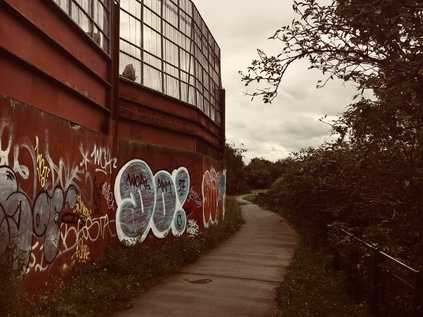
One unexpected bonus of having to head north via Wembley Park was a sighting of the Wealdstone Brook. With the stadium's signature arch looming giddily overhead and the wrap of neon advertising screens around its perimeter casting an unreal blue light over a growing district of towers and retail outlets, it was comforting to find this little river occupying a gully in the floor of a deep, wide culvert. The brook is seemingly a somewhat ephemeral stream in drier seasons, but it flowed nonetheless. Wembley felt like a western reimagining Stratford in a way that the Westfield outpost at Shepherd's Bush never quite has. Perhaps it's the availability of open, former industrial land to pepper with student accommodation and luxury flats, or the relatively poor finances of the host borough allowing them to be persuaded to part with extensive permissions to allow rapid, high-rise development? In any case, like Stratford, the job is unfinished here too. A few steps along the edge of the Wealdstone Brook and I was deep into a unwelcoming and litter-strewn industrial estate which skirted the railway land. The brook meandeed back and forth, and I was intrigued by following its progress - so much so that I strayed past a gate and into a contested street which appeared to be privately owned. Trucks thundered between warehouses and cars were haphazardly abandoned without any thought for access. I was the only human here who didn't glow in hi-vis, and I was conspicuously not hard-hatted or safety-booted. A group of young Polish men watched me from a perch on a convenient concrete block, scanning me as I walked by and murmuring. They were more likely to wonder why I'd want to come here than if I was permitted to be here, I reasoned as I tried to exude confidence and purpose despite a growing limp and a sheen of sweat from walking in a coat on what has turned into a warm day. Finally back on semi-public land, I crossed Atlas Road and passed into Brent River Park. The name promises much, but the reality is a narrow strip of woodland between warehouses and aggregate depots - in its own way though, it is an oasis. Deep below the path, the Wealdstone Brook met the Brent, and the invigorated river turned southwards again. The walk here was surprisingly pleasant given the somewhat down-at-heel feel to the area, and I was largely alone until the underpasses which carry Great Central Way and the railway which it is named for overhead. A cyclist caught up with me, politely dinging his bell as he passed. The path broadened into the edge of Tokyngton Recreation Ground - and again I've been here before, having briefly entered the park to walk parallel to the North Circular. Today I walked the full length of this rather fine green space, noting that the Brent was considerably less noisome and more animated than the still, green waters I found back in the summer. The path was uneven and surprisingly tough going as my feet tired and ached, but I pressed on for the crossing of Harrow Road. A huge crop of Shaggy Ink Caps, a surprisingly large mushroom sometimes known as Judges' Wig, peppered the grass between the river and the path. Above the trees the arc of Wembley Stadium fills the middle-distance, a reminder of the diversion I've taken to get here. The river disappeared into culvert alongside the concrete staircases and tower footings of Wembley Point, and once again I was marooned beside the North Circular briefly, and reminded of how the road and the river are intricately related here. I pressed on into the industrial hinterlands of Stonebridge Park, passing under the railway from Euston and near the Ace Café. The sky was greying distinctly and the day feels ominously short now.
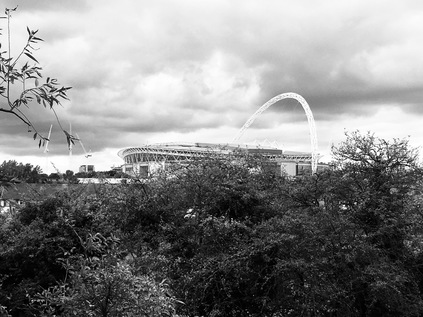
I wasn't sorry to pass under the odd combination of aqueduct and bridge carrying the Grand Union Canal over the A406 and to turn aside from the road again. The Brent surfaced behind the grimly utilitarian Travelodge and I was able to walk close beside it once again on Queensbury Road which marked the edge of the Abbey Estate and the southern edge of Alperton. An unofficial but well-worn path ran along an embankment beside the river, with a broad strip of grassland separating it from the road. On the other bank, a wall of industrial premises filled the space between the North Circular and the river. My hasty planning indicated that this makeshift footpath joined an official route which passes under the Piccadilly Line beside the river, but it soon became clear that the way was blocked by building works. Faced with another diversion, my spirit was almost broken. The only escape was to cross a tiny footbridge over the Brent, edge my way between industrial units on a permissive path and return again to the North Circular. I found myself approaching the Hanger Lane Gyratory once again, this time from the east. Little changes here - the traffic is still solidly blocked - moving almost imperceptibly around the junction, and the fumes hang as heavily as ever above Hanger Lane station on its isolated island site. This time I turned north onto Ealing Road to regain my route. The river took a more direct journey, and reaching it as it passed under Vicar's Bridge seemed to take a long hike. Here at least though, the Borough has had a short-lived outburst of pride in the waterway which provides its name, with a battered but sizeable sign marking its crossing. Beside the bridge, an ill-maintained but wide and street-lit path with an associated cycleway disappeared around a corner. This felt initially promising, and I headed into the cool green tunnel formed by the overhanging trees, skirting a bunch of off-duty supermarket workers necking Fanta laced with vodka and kicking off their weekends in a somewhat down-to-earth style beside the Brent. The river was hemmed in by buildings and ran swiftly in a channel here, but I was pleased to be beside it again. The direct footpath offered some hope of making a little more progress than I'd expected given the day's frustrations and an unexpectedly shorter route might keep me moving for a little longer. But then, suddenly, the path disappeared. The flagstones ceased, and the cycle path stuttered into a muddy emptiness with just a single streetlamp as an ellipsis. This was at least an indication that there was some intent to go further, but presumably the cash ran out. Instead I'm forced to turn aside into the nearby Industrial Park. The threatening clouds choose this moment to burst above me. The dry, dusty pavements reeked in the rain. There was obvious way forward and I found myself involuntarily back at Vicar's Bridge, drenched and having gone nowhere at all. It's the final straw for my tired feet. I have enough energy left for a push onwards to find transport home, but not more. The Brent - assisted by my foolhardy lack of planning - has beaten me today.

I trudged along Alperton Lane, the rain coming down heavily now, knowing that the river was weaving its way along the edge of the golf course some way to the south. A dated brown sign welcomed me to the London Borough of Ealing, while the tail-fin of the Hawker Hunter jet stationed atop the headquarters of Vanguard Storage was camouflaged perfectly against a grey sky. The strange collection of objects here are the personal collection of Mac McCullagh, the firm's owner, and from other angles field guns and buses can be seen topping the fine brick buildings of Vanguard's headquarters. My aim now was Perivale Station, a mile or so away along Western Avenue, which I joined at a noisy junction near a drive-through coffee shop. I resisted the urge to enter and rest - if I didn't press on to Perivale right now I'd probably never get my legs moving again. I calculated the time and distance wasted on diversions, skirting around obstacles and badly-planned turns, and compared it with the three miles or so left of the river to Brentford. Giving in felt like a defeat, but it had been a noble effort. Walking west always feels tougher going, and today had been a fine challenge. My one last treat was to be a pedestrian passing of the splendid Hoover Building, completed in 1933 and designed by Wallis, Gilbert and Partners in textbook art deco style. However, as I approached I realised that the main block had disappeared behind scaffolding and screens to protect the Grade II listed building during refurbishment. The smaller buildings at each end of the long, low sweep of the block were all that could be seen - but this allowed me at least to get a glimpse of the canteen building, a modernist gem in its own right. Beaten yet again I turned north and headed for the curiously stubby curve of Perivale Station, with an additional wing and tower extension cancelled as a post-war economy. It remains a fine building though, and the curved glass clerestory was a welcome sight today in particular. Once inside the sinuous canopied stairs led me up to the island platform with views back over Wembley - and tantalisingly, south towards Brentford. I let an eastbound train pass, enjoying the calm of the empty station. The rain had stopped and a golden sunset was promised by the western skies. I reflected on my hubris - imagining I could set out with almost no planning and manage to deal with the twists and turns of an urban river. I was walking well off my territory, straying into the unknown in a way which felt liberating and challenging - but which had rather strangely sapped my energy. The remaining walk along the Brent to the Thames promised further revelations, and it could wait. I hobbled towards the arriving train, plotting my next excursion in the west...
You can find a gallery of photographs from the walk here.
The destruction of London is an unsettlingly familiar trope. There is something which seems to deeply satisfy authors and readers alike in the toppling of seemingly infallible towers or a surging tide along the sinuous Thames. While it's title is similarly apocalyptic The Last London doesn't describe a literal ending - but suggests a city which has reached its final condition. It is an ending though in another sense - the final work in a cycle of of semi-fictional novels and essays which have tumbled out of Hackney since 1975. Taken together these books form a remarkable cultural catalogue which documents the sometimes jarring changes which have wracked the city as it shudders into the 21st Century. London often feels briskly futuristic on its face, but in truth it always lags behind. Things change disarmingly slowly in a city of this impossible size and complexity, and it takes a sharp jolt to propel London forward. Sinclair posits the 2012 Olympiad as the moment things change. The moment which London enters its final phase. The moment at which he starts to step away from the city, their paths forking in distinctly different directions. The Last London draws the themes which have emerged in his work since 2012 to a spectacularly written conclusion.
It also marks a distinct shift in Sinclair's writing style which brings his exasperation to the fore, electrifying and spiking his prose and rendering it curiously similar to some of his earliest poetic works on London. I've seen commentators bridle at this frustration and irascibility - but I think in a literary career which has spanned well over forty years and countless revolutions in the experience of navigating London, Sinclair has earned a hearing. The irritations which he catalogues as he moves around the rapidly evolving city are individually innocuous but collectively deafening. The flow of digital information along unmediated channels challenges the well-walked paths and mysterious connections which Sinclair has meticulously mapped and remapped. These old ways are clogged with cyclists who have no time to avoid pedestrians now. The sense that devices demand maintenance and drain agency from the people moving around the city's boroughs seems a minor inconvenience to the rest of us until we're facing down a crowd coming the wrong way, heads down, minds elsewhere. It's easy to dismiss the exasperated tone which some passages in the book take as the snarls of a man aging at a different rate to the city - but almost all of them have rung true at some point, even to a relative technophile like me.
The Last London begins in Hackney with a sage-like silent man on a bench in Haggerston Park, and slowly expands to the limits of the London which Sinclair has written himself into, and now out of. The journeys this time though are partially an act of erasure - undoing his London Oveground circuit by reversing its direction, revisiting the docks and dereliction of Downriver after the passing of 'The Witch' and finally venturing into the stage-managed artificiality of the Queen Elizabeth Olympic Park left behind by the Grand Project. By the time the circuit is completed, the mysterious presence has gone from the park. Things are changing again, London is being remade in the image of Beijing or Bahrain. Legacy and Inclusivity - once the bywords of the Olympic city - are now virtual concepts which rarely make the leap into reality from the computer generated vistas which wrap new developments.
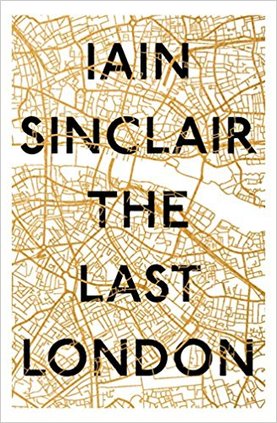
As the book approaches its conclusion, Sinclair is on the hoof again in pursuit of the next London, if indeed it exists. His walk from Gospel Oak to Barking in the company of (literally) ghostwritten friends who have gone, charts the path of the partially-electrified railway which will eventually spark life into the provisional community rising from the sedge and mud at Barking Riverside. There is a point on the journey where his narrative splinters - the narrator is no longer the walker as he pushes over boundaries and into sectors of the suburbs which are outside his experience. It's strange, and liberating as a long-time reader of Sinclair, to feel the author's raw response to the strangeness of this hinterland. He crosses the North Circular into Barking and recognises the kind of territory he used to occupy pushed out here to the margins, and soon to be pushed back further. He is spun back to Hackney in relief - that he has left Barking, or that places like Barking still exist?
The series of walks which are described in the final chapters of The Last London have another function - they detail those who will continue to walk and record. John Rogers, Andrew Kötting, Effie Paleologou - in words, film and images they have already long since taken up Sinclair's mantle. They walk beside him, and they'll carry on walking into their own Londons and beyond. Their work is generously referenced, openly admired. Their activism and vigour a match for the demands of the last London - their variations on Sinclair's themes spinning off into new territory, new media, new technology, but always anchored into a shared past. Thinking of the influence of Sinclair's now extensive body of London writing, I wince a little on reading my own over-egged thoughts here and see an homage to Sinclair in every description of a decommissioned facility or deleted franchise. The companions on these final walks are commended to us by Sinclair, not least for his appreciation of their ability to navigate the city in its current situation. They are doing what he can't now, receiving messages which are incompatible with his self-confessed duncephone. The book closes with a final pilgrimage - an account of the march from Waltham Abbey to St Leonards on Sea which morphed into Kötting's Edith Walks film - once again piercing the skin of the M25, out into the fractious hinterlands where 'Vote Leave' signs line the lanes. Out of the city, out of the UK, out of Europe. The uncertainty of the future weighs heavily on Sinclair, and he almost pines for the easier times under Thatcher when the needle on the national moral compass was inverted rather than spinning erratically. A time when satire didn't turn eagerly into newsprint with each dumb tweet from Donald Trump. It's down to these new walkers to make sense of the next London in a post-factual, digitally altered world. It would be a gloomy way to pass out of the city if it wasn't written with such vigour and precision - Sinclair is playfully pithy to the bitter end of his walk, enjoying the freedom perhaps of looking back on London?
The Last London is as ever an erudite, complex work which will have readers reaching for references and chasing down works by Sinclair's kindred spirits. It's not an easy read, but it rewards time and effort to untangle the threads of myth and modernism which wind around his map of the city, reaching out to his coastal redoubt. While it refers deeply into Sinclair's history of writing on London, it stands alone as a guidebook to future cities which exist everywhere and nowhere. Perhaps it also sounds a call to the next generation of pavement botherers, mythmakers and diviners of this ancient, ever-changing city. If they turn in an account half as vital and detailed as this, there is an interesting future in the written city.
You can read, and hear, a discussion between Iain Sinclair and John Rogers about The Last London at The Lost Byway.
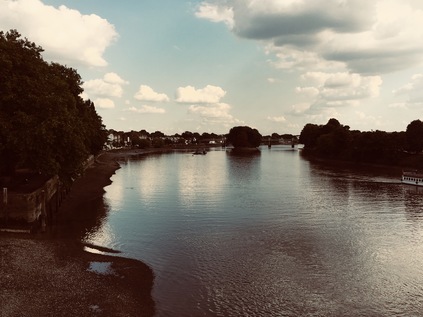
London's Other Orbitals: Unbreaking the Circle
Posted in London on Saturday 2nd September 2017 at 10:09pm
Despite my careful attempts to end the last leg of my walk somewhere I could easily pick up the threads, my arrival at Forest Hill had been a little fraught. With rail services not calling today due to planned engineering works I'd somehow entirely missed, I'd headed instead to Catford via a departure from the impressively extended and modernised Blackfriars station. While there, my bank card had been rejected by the ATM leaving me in a state of mild confusion and paranoia. I didn't even notice how bright the morning sun had turned as I headed for the bus stop near Catford Station and hopped on board. Not until I'd had managed a successful transaction at Forest Hill Sainsbury's was I assured that there hadn't been some sort of financial mishap. These things always bother me - and the prospect of a conversation with my bank instead of walking this morning wasn't edifying at all. As I stepped back out into the bustle of surprisingly gentrified Forest Hill I sighed with relief. Perhaps I was ready for this after all? Completing the circle seemed impossibly far off - but it had become something of a cause now. This leg of the trip would take me into areas I simply didn't know, and which I couldn't connect with any of my other wanders at all. That in itself felt strange - so many of the unexpected pleasures of the last few walks around the Circular Roads were in turning unknown corners to find familiar views from new angles. This was a different excursion - deep into the suburbs, in almost the opposite direction to that in which I comfortably tend to turn. I dodged sturdy designer prams and expensive bikes to gain the outer edge of the pavement in order to get an angle on the sign of 'Ferfect Fried Chicken' - this legendary local eatery was allegedly unprepared to pay to use the existing name when the shop was purchased from a group of franchises, and so a surprising accurately matched 'F' was tiled over the sign. The fact it makes absolutely no sense appears to have troubled no-one, and so in the midst of the rapidly upscaling Forest Hill townscape, opposite the rather fine old 1920s Capitol Theatre turned Wetherspoons, the errant chicken purveyor remains. This felt like the perfect place to begin walking. The beginning of the end of the South Circular...

As I climbed away from Forest Hill, still surprised by the upturn in its fortunes in comparatively recent times, I saw the tower of the Horniman Museum appearing at the crest of the hill amidst a cluster of greenery. Charles Harrison Townsend's curious 1901 design fuses Arts and Crafts decoration with a rather foresighted and clean lined modernism, making for an odd but pleasing building, sitting almost at the brow of Forest Hill. The museum itself houses Frederick Horniman's extensive collection of curiosities, purchased with the proceeds of his inherited tea trading empire. The collection majors on cultural and anthropological history, and has a legendary collection of taxidermy and musical instruments. There was no time to check out what sounded like a charmingly odd expression of one man's passion for collecting today, instead I slipped into the surprisingly capacious gardens beside the museum to find a spot to apply sunscreen and chug cold water before setting off in earnest. I found the rather beautiful grounds of the museum busy with locals out for a stroll and families working on what appeared to be an edible garden project. The pathways curled around the site, luring me deeper into the wooded nooks. The temptation to explore further was strong, especially because the northern edge of the site offers impressive views over London from the comparatively high ground of the hill. Instead I set off west, crossing the former trackbed of the London Brighton & South Coast Railway's branch to Crystal Palace High Level. Much of the railway can now be walked as part of a nature trail running between the suburban streets, and which after crossing the South Circular, climbs into the woods of Sydenham Hill. Having never recovered traffic following the destruction of the Crystal Palace by fire on 30th November 1936, the line limped on until 1954. It has the dubious distinction of being the first electrified mainline railway line to close in London. Now it's a barely discernable hump in the road, the path disappearing into the Lapse Wood Walk housing estate where some remains of the line can be spotted by the eagle-eyed. I trudged along the road towards it's awkward junction with Lordship Lane, choosing unwisely to attempt to cross near 'The Ferns', a very early attempt at constructing a home entirely from concrete dating from 1873 by Charles Drake's Patent Concrete Building Co. In disrepair for a while, it was good to see that a recent refurbishment had restored it to former glory, while retaining the name of the property. I had a while to ponder this feat of engineering as I waited for a gap in the traffic on the South Circular...
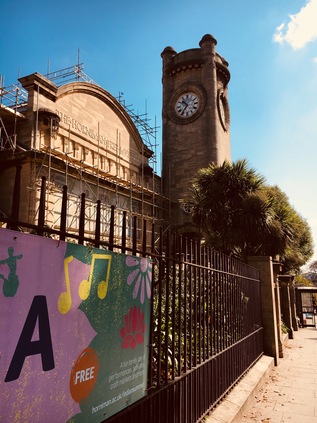
I had only the vaguest idea of Dulwich. Somehow I'd cobbled together an idea of the place through the oddest disconnected parts: Margaret Thatcher, the Picture Gallery, the exclusive, private college which produced the odious Nigel Farage. While all these things form part of this curious place, there is something stranger at work here. Dulwich, despite being sandwiched between areas not far away which are challenged and struggling, is an incredibly genteel neighbourhood. The green, wooded slopes of Sydenham Hill rise high above the broad playing fields of Dulwich College, home to the Old Alleynians - named for Edward Alleyn, actor and founder in 1619 of 'God's Gift College'. Beyond them, the almost impossibly tall transmitter tower at Crystal Palace strikes the skyline. Snaking around the edge of the sports ground is Hambledon Place, a gated community of large modern dwellings, perhaps surprisingly built by Barratt Homes, in the style of the large mansion houses which line the other side of the South Circular in Dulwich. Behind these gates, a battle-scarred Margaret Thatcher briefly reflected on her ousting from Downing Street. She had taken her husband's advice and purchased a bolt-hole to which she could escape when her increasingly inevitable downfall occurred, and the proximity to a good golf course bears his influence too perhaps? Dennis is reputed to have suggested she could wander down to the village with her basket to shop, and then a car could pick her up and take her to the Lords for a vote, which perhaps suggests more about Dulwich than it does the Thatchers. In the event, Margaret and Dennis didn't spend a great deal of time in Dulwich before their repair to Belgravia, and the local association with them is perhaps unwarranted. I lingered on the corner trying to decide if I could poke my camera through the automated gates, festooned with cameras and electronics. As I decided, a large, sparklingly clean Landrover cruised up to the gates, the driver a middle-aged Indian man wearing shades and the garb of a country gent out for the shoot. "What are you doing here? Why don't you fuck off?" - there was no pause for a response between his two plainly rhetorical questions. I silently did as I was told, cursing my failure to defend my ground on the public highway outside the gates. There was something in his response which typified Dulwich too. As I've walked the Circular roads, I've encountered a surprising number of clandestinely privatised places: edgeland strips of littered scrub protected by a forest of cameras, retail parks under constant surveillance, gated communities like Hambledon Park. But there is a more sinister edge here in the affluent south. There are areas where a tyranny of manners guards access - where you might 'look' wrong and the fear of being asked what on earth you think you're doing here guards against intrusion. Perhaps only in Britain - maybe only in London - could this work so effectively to repel the unwanted? I definitely felt that I wasn't required here in Dulwich, and as I hurried along the perimeter of the college, its beautiful gothic buildings largely concealed by scaffolding as it was buffed and repaired for another lucrative school year, I was acutely aware of the this entire area being carefully managed. The Dulwich Estate centres on the various schools and colleges, and its long and complex history records generations of very smart investment, clever capitalisation of legacies and maximisation of income. Indeed the estate still operates the only remaining toll road in London, though this most traditional but financially savvy of institutions does allow locals to pay via an electronic tag. The rigorous preservation of a certain kind of English village life, coupled with an astute sense of being an island within a vast city makes Dulwich feel self-aware, a little apart, overtly stage-managed. I wasn't sad to pass over the boundary.
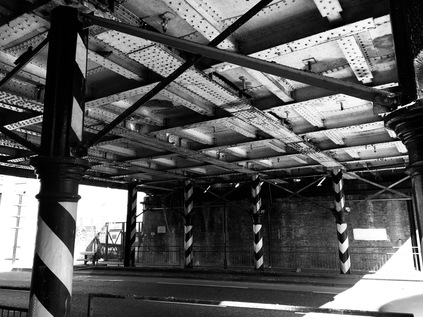
The transition from Dulwich to Tulse Hill was however, something of a jolt - the quaint wooden fingerposts and crimped lawns of the Dulwich Estate gave way to the well graffitied and apparently disused Variable Message Signs which were about the only hint of the strategic importance of the South Circular. A few stray flags on lampposts urged me to 'Love West Dulwich' - an area which appeared to consist entirely of an attractive if rather sparsely used railway station and a tricky to navigate crossroads with the route to Herne Hill. The quiet suburban area clung to its eastern and more affluent neighbour desperately. There really isn't any West Dulwich aside from the railway - but they're trying really hard to believe there could be. A low bridge where sleek, new Thameslink trains passed overhead marked the boundary, and yet another badly thought-out gyratory spun the road around the Victorian centre of Tulse Hill. It struck me here that the most problematic spots on the South Circular were often where well-meaning attempts to improve traffic flow had been implemented. This area was largely undeveloped until the early 19th century, and only really became populous after the railway arrived in 1868 when the difficult geography and the straggling forested remnants of the once extensive Great North Wood finally gave way to a district of rather plain and functional terraces. The last thing I expected to detain me on this leg of the walk was surprising architecture - but descending from the heights of Tulse Hill, the South Circular curves along the edge of the Palace Road Estate. This early 1970s low rise development was built by the Greater London Council and designed by their chief architect, Sir Roger Walters. His modern but subdued buildings snake along the awkward rise beside the road in attractive zig-zagging blocks which lengthen towards the western boundary of the site. His work for the GLC is remarkably distinguished if somewhat unsung, with the Thames Barrier and the rejuvenated Covent Garden bearing his signature. He is perhaps less well known for Perronet House at Elephant and Castle, a modern social housing block dating from 1970 which uses unusual design features to give all residents an aspect at both sides of the building, uninterrupted by external communal corridors. Wikipedia, ever resourceful, reminds us not to confuse him with Roger Waters. We won't, I'm sure. As the road headed further down Streatham Hill towards Clapham, an equally curious building rose steadily above the brow. First a curious pyramid appeared, then a tall, striated brick tower and finally a squat and solidly modern looking church beneath. Christ Church by James William Wild in fact dates from 1841, and is a truly remarkable building. While now essentially an inclusive and suburban outpost of the Anglican Communion with its extensive estate of dull urban churches, this building appears to belong in another time. Meanwhile its patterned brickwork and Star of David rose window seem to come from another continent entirely. After delivering a number of solid but unremarkable parish churches in Hampshire, Wild travelled extensively in Egypt and the Middle East. A period of mysterious inactivity followed his return to Britain, after which he worked on the complex of museums in South Kensington and their outpost at Bethnal Green, now the Museum of Childhood. Perhaps the building that owes most to Christ Church though is his Italianate water tower at Grimsby Docks. The church is an arresting sight in the slightly mundane surroundings of this part of the road - a welcome relief from the suburban monotony of the hinterland separating the boroughs of Lambeth and Wandsworth.
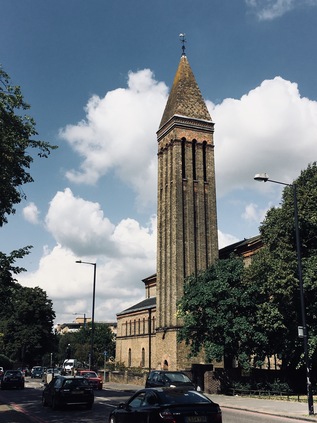
Shortly after Christ Church, the South Circular crosses the A23 on its long trek to Brighton. From here, for just a short section, the road is a broad six-lane dual carriageway. Oddly, this is also one of the quieter sections with most traffic apparently content to head along the radial roads into London or out to the suburbs and the coast. The South Circular soon returns to its ponderous, pottering single-carriageway meander into Clapham, through pleasant terraces and bursts of more recent development. It strikes me that this part of the route must be more affluent - there is a Tesco Metro or Sainsbury's Local on almost every major junction, something distinctly lacking in the eastern quadrant. I'm also aware that I'm starting to head north towards the river, having passed the most southerly point of the road's curve some way back. The arc of the South Circular is shallower than its northern counterpart, returning to the Thames much closer to the West End, and stretching out an arm along the river to the western suburbs. Now though, the road arrived rather unexpectedly at Clapham Common. The junction was busy with traffic from all angles, and crossing was difficult - but sure enough, tucked away between the branches of the road was the squat cylindrical tower which signified the shaft leading to one of the Deep Level Shelters. This network of extremely deep and well-protected tunnels were built when the public demand for shelter from the blitz began to overwhelm capacity around the city. The tunnels echoed stations on the Northern and Central Lines, with the intention that they would be linked together to form an express tube network in peace time. Progress on the building was slow due to wartime labour shortages, and by their completion in 1942 the intensive bombing had largely subsided and demand for shelter had reduced. The Goodge Street shelter became General Eisenhower's wartime base, and other stations hosted troops in transit, but the tunnels were hardly used for their original purpose if at all. They also failed to live up to their intended post war use as new Tube lines, but almost all of the tunnels have found a peacetime role: as document stores, telephone exchanges or even for a brief period during the 1951 Festival of Britain, a hotel. Now however, the rather sorry looking Clapham Common entrance is overlooked by a line of very fashionable eateries and bars stretching along the edge of the common. I knew this area was becoming more desirable and the demographic changing, but to see it in such a sudden burst of activity after the resolutely suburban progress of the South Circular was a shock indeed. But perhaps it shouldn't have been a surprise - Clapham has been fashionable since its earliest development as a suburb, with the spacious villas surrounding the Common providing homes for the 'Clapham Sect' - an informal but influential group of evangelical Anglicans numbering among them William Wilberforce and Henry Thornton. The atmosphere of intellectual and religious freedom which was enjoyed by the 'saints' as they were known, saw them wandering the common between their homes to discuss matters of social and liturgical importance. It was among these houses where the rigorous parliamentary campaigning was plotted which led to the abolition of slavery throughout the British Empire by 1807 and the later emancipation of all slaves in 1833. I followed my route around the smaller, western extension of the common, realising that I would actually lose the A205 briefly for a few miles here as it shared a route with the A3 on its western journey to Portsmouth. The South Circular was now firmly in brackets on the signs - an indignity which its northern cousin never quite succumbed to. It was hard to imagine members of the sect scurrying across this busy swirl of traffic, eager to impart their ideas on freedom and faith to each other.
The road passed swiftly through the busy crossroads of Battersea with its lines of tall, red-brick shops snaking away north towards the railway, and then crossed the northern edge of Wandsworth Common. The Common, though still a large tract of open land even now is divided by a griddle of railways and roads, with a neat arrangement of grand Victorian villas known as the 'toast rack' eating into its western edge. I strayed from the road briefly along Spencer Park to find the memorial to those who perished in the Clapham Junction rail crash in 1989. The simple curved stone commemorates both the 35 victims of the crash, and those who worked to help them on the morning of 12th December 1988 when a simple but ultimately catastrophic signal failure resulted in a collision involving four trains in the deep cutting below Spencer Park. Some of the first on the scene were staff and pupils from the nearby Emmanuel School, and as I contemplated the difficulty of clambering over the palisade fencing and down the steep bank to the railway to offer aid, some of the current pupils passed by heading back from sports practice. It was hard to imagine these young people, full of chatter and innocence, having to deal with some of the horrors that day. The carving on the stone shows a hand grasping another from above, which felt perfect for this memorial. The safety culture of British Rail was changed greatly by the crash, but just a few years later the privatised railway would need to relearn some of these lessons all over again in other parts of London. As it stands, the railway in the UK is now possibly one of the safest in the world - but it felt cruel and tragic that this incident and others like it were the necessary catalyst for this change.
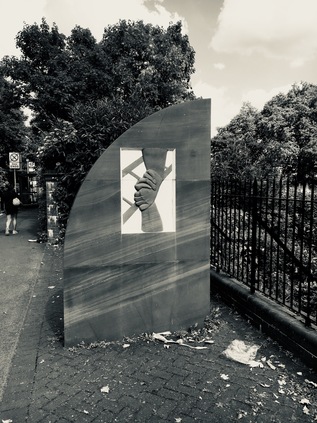
Soon after passing Spencer Park, the road crossed the rather grander A214 - one of the few completed relics of a scheme to connect two of the unbuilt and much maligned London Ringways, which would have included a rather steep, ski-jump of a flyover if fully realised. Ploughing south from the infamous Wandsworth Roundabout, the road is a broad dual-carriageway in a deep concrete cutting which gouges deep into the Common. Rising again to the south, the road is a broad, urban arterial with a tree-lined median - and is perhaps one of the best indicators for what the road network of London could have looked like had the Abercrombie plan or even the GLCs later revisions come to fruition. As it is, the A214 soon becomes a fairly mundane suburban route out to Crystal Palace and West Wickham, leaving this section in Wandsworth a somewhat over-engineered and marooned hint of what could have been. The A3 and South Circular continued west in combination, passing 'Mount Nod' - an abandoned and currently inaccessible Huguenot Burial Ground - and descending into the valley of the River Wandle which the road crosses in Wandsworth Town Centre. My only vague knowledge this area was from frequent travels on the railways which pass largely beneath the town, and I was a little surprised by Wandsworth. The eastern approaches pass the impressive Town Hall which still provides a civic centre for the Borough. A wedding was taking place in the inner courtyard, perfectly framed by the Portland stone entrance which faces the street. Along the wings of the triangular building, stone reliefs depict scenes from local history above manicured lawns and pristinely weeded flower beds. Years back, I'd stayed in a down-at-heel budget hotel a little way towards Clapham Junction and had developed an assumption from its hinterlands that Wandsworth was a grim and unprepossessing place, being swiftly encroached upon by dull riverside apartment blocks. If only I'd strayed a little further from my digs perhaps I'd have found this building and thought differently. Disappointingly there was no access to the River Wandle at present as the redevelopment of the former Ram Brewery has temporarily closed the pavement on the north side of East Hill. Behind the wooden fences a range of waterfront properties can be seen rising slowly to form the almost inevitably named 'Ram Quarter'. Wandsworth is about to change it seems - and The Ram, an inn which can trace its history back to 1550 or thereabouts, is again a central part of the story. Young's brewed their last beer here in 2006 with production subsequently moving to Charles Wells in Bedford - but the developers of the site in Wandsworth have committed to the presence of a 'nanobrewery' in the former laboratory building to continue the tradition. For now though, the northern side of the street was off limits, the old Inn's frontage disappearing behind hoardings to rise again as a protected feature of the site. Forced to cross the street I noted that the river disappears under the Southside Shopping Mall here surfacing some way south, and as I strolled through the reeking clouds pouring from a grill in the pop-up street food market on the broad pavement covering the river, I rather wished I could see it. The Wandle is possibly the very first London river aside from the Thames which I'd learned about by way of Michael de Larrabeiti's novel The Borribles which I read as a child in the early 1980s, long before I'd ever visited the capital. The vision of a dark, confusing and unforgiving city conjured in this novel with hidden layers of meaning has perhaps never quite left me. It was also perhaps the first book which treated me like an adult, refusing to pull punches or sugarcoat disappointment, and it left a strong impression of a dirty, shifting city with curious culverts and sinister people living altogether disconnected lives in the unknown suburbs. The characters squatted in derelict houses, openly questioned authority and spent their time evading the Police. It's hard to imagine the book being published for children now - the concept of young adult fiction had re-emerged in the 1960s and the discovery that there were books other than those about the triumphs and tribulations of football teams or impossible space battles arrived with my slightly advanced reading age. It's fair to say that de Larrabeiti's work stayed with me for long years after reading it, so much so that on an expedition to Streatham Cemetery to research William Kent twenty years later, a glimpse of the River Wandle played a part in reigniting a reading and walking habit which in many ways led me to this very point, hovering above the same river. I thought back to that walk from Haydon's Road station through industrial hinterlands. It took me a good while to find the nerve to make that kind of trek, and now it was practically my modus operandi. Times changed, but the oldest of influences seemed to remain. I was disappointed not to spot the Wandle today - but knowing it flowed into the Thames nearby, and passed beneath my feet was curiously edifying.
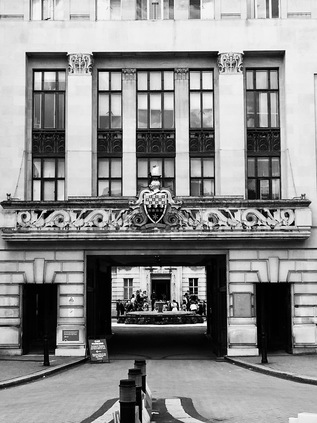
Climbing up West Hill out of Wandsworth, I began to realise just how far I still had to go. The sun was still bearing down on me, and the long, flung out arm of the South Circular seemed endless. I was determined to reach the end of my walk today if I could. I bought more water from a Tesco nestled uncomfortably into a tiny, rather quaint corner shop building and set off again. It wasn't easy going, in part because it soon became apparent that this section was going to be relentlessly suburban and featureless. I put my head down and walked, crossing the site of Beverley Brook which was now in culvert with only an old bridge wall remaining beside the road, and skirting the wild and interesting edge of Barnes Common to the north of the road. Here the Thames, the railway and the road ran in parallel along the same flat plain, and signs frequently directed me to stations for places which were notionally on my route, but were in reality just a little way from the South Circular. The lack of importance of the road explained its largely unimproved state here in the west. There were always other routes to get to places more quickly or directly. The A205 was a bypass for nowhere. At East Putney, the Underground provided a brief distraction with an intriguing pagoda sitting in front of the brick built station entrance, while white stuccoed totems declared the station name across the broad V-shaped gap between the lines. Entirely over ground here, two fine old iron bridges pass over the road - the easternmost arm of the junction carrying the little-used curve from TfL's network to the mainline railway at Point Pleasant Junction - one of the few pieces of track in London which I haven't travelled on. Putney straggled along the road a little, the main and far more affluent centre a little to the north around the mainline railway station. Soon the road returned to suburbia. I began to seriously wonder if I would complete the walk today - my feet were tired but still game for the walk, I was hot and tired but not unexpectedly so. It was the sheer unrelenting suburbanity that was sapping my will. The suburbs of the south are different to those of the north - often more uniform, less grouped into villages defined by ancient geography. The south benefited from large swathes of common land which have been worried away at over the year to produce vast estates of visually similar homes ranked in long, straight avenues. It felt like I was walking directly across one of these. It felt never-ending.
The South Circular ploughed on through a place which might have been East Sheen or Mortlake, the main business streets of the latter having moved south, away from the river over centuries in favour of riverside dwelling opportunities. The A205 now formed the long and pleasantly prosperous High Street, traffic sluggishly navigating the side-streets, nosing into unlikely parking opportunities. At Milestone Green, the road from Mortlake Station to nearby Richmond Park crossed, and I realised an odd thing about the South Circular - in the effort to give the road a much-needed identity in the absence of an actual coherent route junctions have been 'named' like those around other major routes. However, the names appear to have little local resonance at all. The last few miles had produced numerous named 'gyratorys', 'Red Rover' and now this junction - none of which seemed to have gained any traction as a local feature or even any obvious history. The South Circular's disguise was wearing ever thinner as I approached its ending. It had one more trick up its sleeve though - up ahead, as the shopping area of East Sheen dwindled into the ubiquitous run of small offices and tyre dealers, it made its last abrupt ninety degree turn to the north. The road ahead continued, unperturbed to Richmond while I was directed to turn right for Ealing and the M4. I climbed a railway bridge and passed between Fulham and Mortlake Cemeteries on a lazily curving trajectory along the tongue of land on which Kew nestles, in a broad meander in the Thames. The National Archives were held here, beyond the perimeter of an unprepossessing and oddly sited retail park. The solid, concrete block giving an assurance of the safety of our history despite much of the collection now being digitally stored of course. A final railway crossed the road - bringing the District Line and Overground from Gunnersbury where this whole sorry enterprise had begun for me. I could smell the Thames now. Around Kew Green, the road developed a new character - artisanal stores, little bistros, gastropubs with deliberately distressed furnishings and lots of grey paintwork. It felt oddly familiar - distinctly like North London, and a jarring change from the quiet suburbs I'd just crossed. As I navigated around double-pushchairs with wheels built for off-roading, complicated families groups filling the entire width of the footway and endless pavement cyclists with no regard for humanity, the appeal of quiet suburbia began to feel stronger. Across the street, my walk had one final surprising building too - St Anne's Church, built in 1714 but much extended by the patronage of both Kings George III and William IV. The red brick and verdigris of the church winked between ancient, swaying trees as I pushed on, asking my feet to give me just another mile or so if they could. The sun escaped from cloud cover again, and the church glowed on the green. It was a curiously inspiring sight.
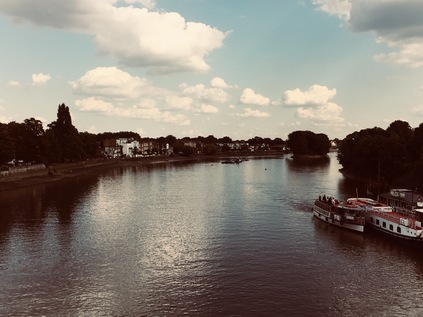
The arrival of the Thames was heralded by two events - a sudden cool breeze drifting from the east, and the arrival of a noisy group of over-dressed wedding-goers attempting to have their picture taken on the busy riverside path. The bridge arched gently over the silvery surface of the river, and I dodged oncoming pedestrians to get a picture looking eastwards. The wooded thicket of Oliver's Island divided the flow of pleasure craft, now largely a nature reserve but historically a toll booth for river traffic with legends of Civil War era tunnels to Strand-on-the-Green on the northern bank. I paused for a while - this wasn't quite the end of the road, but it was a significant enough milestone to make me reflect on this trip. I summoned the will to push on, tired and beginning to feel the effects of a cold which had dogged me for the last few days, but which I was determined not to succumb to. Landfall brought me to the boundary between the boroughs of Hounslow and Brentford, and the busy junction in front of the Express Tavern. The view to the east was dominated by the tall water tower of the Grand Junction Waterworks Company - now the London Museum of Water and Steam. I however, needed to turn west along the final section of the South Circular. Now the road was north of the river, it had become a busy and businesslike continuation of the North Circular at last - a four-lane dual carriageway running between dilapidated shopfronts and retail parks. It seemed comfortably familiar, and the sight of the towering glass hotels and offices around the beginning of the M4 up ahead felt almost like coming home. I picked my way around the south-eastern quadrant of Chiswick Roundabout, alongside Surrey Crescent - the remnants of a row of once rather fine houses which were largely demolished to create the flyover, opened to much ceremony and glitz in 1959 by Jayne Mansfield in a 'skin-tight crimson dress'. These slightly grubby but grand homes have survived in its shadow against the odds. I turned the corner onto Chiswick High Road and rather suddenly found myself at a familiar spot. Above me was the roadsign which I'd taken a snapshot of before heading off to walk the first section of the North Circular. I recalled the amused tourists from the nearby hotel who had sniggered at me for taking the picture, and wondered if they'd imagined I'd planned to walk all the way around the city, back to this spot? I'm not sure at that point whether I'd even quite formulated that idea fully then. Certainly, there were times - especially on this tough final leg - when I'd wondered why I set myself projects like this? When I had complete control of the rules, why would I make them harder than they needed to be? This walk had taken me into southern suburbs I'd been content to 'know' only through passing by train, areas where I felt alien and uncomfortable, where I was in many ways, lost. I'd seen places which perhaps only locals would normally regard, and then only with the tired eyes of the familiar. I'd surprised myself by finding places I'd wanted to revisit to explore, ideas for future excursions and connections back into my past reading which intrigued me. I stood beneath the sign and felt the need to celebrate - I contemplated emptying the refreshingly cold contents of a bottle of Sprite Zero over my overheating and aching head, but I thought of the tourists and figured I shouldn't give them the excuse for another chortle at my expense. I calculated that the journey around the North and South Circulars totalled around fifty-three miles of walking which had taken me into the depths of suburbia, into the forest, along the banks of hidden brooks and through the complex geography of the city. It felt like a strange privilege to be able to make this circuit, and to spend time researching and recording what I'd seen. I often questioned if my records of these walks were ever read by anyone, but figured it didn't matter. I wasn't the first to walk around London, I wouldn't be the last and I had few original insights to impart. But I'd honoured a city with which I've had long and complex dealings by walking around it. For a few moments at least, while my aching feet were forgotten in the thrill of completion, It felt like an entirely sensible thing to do.
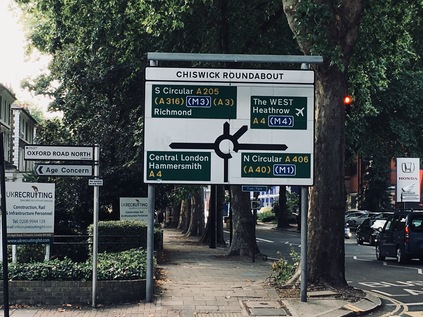
I shuffled the short distance to Gunnersbury Station and caught a train, deciding to cross the street and change for the Circle Line back to Paddington when I reached Hammersmith. As I sat on the train, trundling quietly over the rooftops on a viaduct with the sun picking out the yellow London Brick of the rows of houses beneath, I suddenly realised my route would pass the wreckage of Grenfell Tower. As we left Latimer Road station, the blackened view into the lower floors of the block filled the windows of the train, shockingly close to the line. Stripped back to the concrete core on this flank, the gaping windows gave a view entirely through the gutted structure. It was horrible to behold, and terrifying to imagine being within the conflagration. As the line curved to the west and the building slipped slowly into the distance the full horror was revealed, standing like a single dull, dead tooth in the blue sky. I looked around the sparsely filled carriage, but everyone else was busy reading, talking to their fellow travellers or just looking at the floor in the time-honoured way of the Tube. I wondered if I was perhaps the only one who hadn't seen this before? The only one who hadn't had to live with this expression of loss and death above me on my daily comings and going? It was a haunting image - so different to seeing it on the screen and often reduced to a backdrop to a political dialogue - either a timely reminder of inequality or a tragic bandwagon jumped by protesters depending on one's viewpoint. I don't think I'll ever quite forget the sight of the tower, abandoned but still glaringly present in the skyline. It haunted my dreams on the sleepy train ride home, vying with the views of collapsed viaducts in Los Angeles back in 1994 for its utter alienness and unreality. Whatever the outcome of the investigations and discussions which the fire has precipitated, whatever the fate of the officials and trustees who appear to have slalomed around regulations to create the conditions in which this could happen, these events are an exclamation mark in the story of London life. A point for pausing to consider the gravity and complexity of life and death in the city. As a full-stop for a circumambulation of London, it was both fitting and sobering. I hadn't just walked around a landscape or a museum, I'd circuited a living and dying metropolis of diversity and disparity, where eight million souls struggle beside each other. When I'm next asked the question 'why?' I make these walks, perhaps I have the beginnings of an answer...
You can find a gallery of pictures from the walk here.
Lost::MikeGTN
I've had a home on the web for more years than I care to remember, and a few kind souls persuade me it's worth persisting with keeping it updated. This current incarnation of the site is centred around the blog posts which began back in 1999 as 'the daylog' and continued through my travels and tribulations during the following years.
I don't get out and about nearly as much these days, but I do try to record significant events and trips for posterity. You may also have arrived here by following the trail to my former music blog Songs Heard On Fast Trains. That content is preserved here too.


